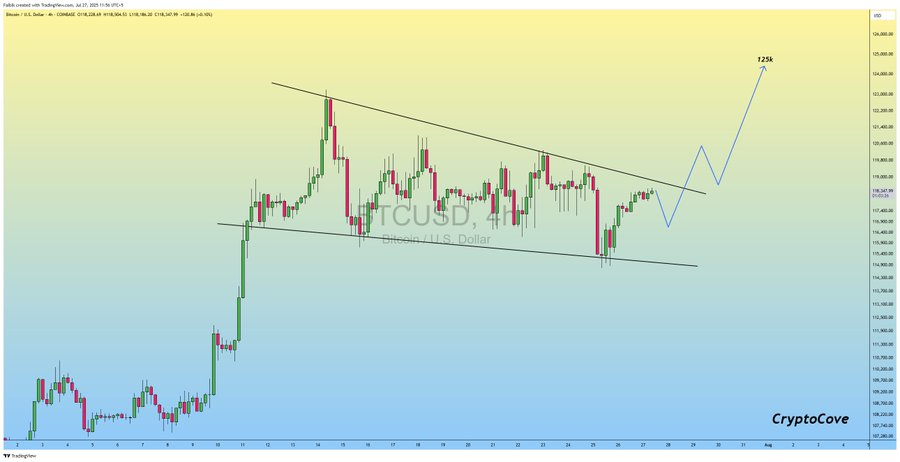Bitcoin is expected to surge to $130,000 by 2025 if it maintains support above $110,000, fueled by ETF inflows, a supply squeeze, and sustained institutional demand.
-
Bitcoin could reach $130K if it holds above the $110K–$112K support zone, as indicated by the MVRV Pricing Bands model.
-
ETF inflows and a supply squeeze are key drivers supporting Bitcoin’s bullish momentum and long-term price growth.
-
Bitcoin currently trades above $117,000, with $119,500 acting as a critical resistance level for a potential breakout.
Bitcoin could hit $130,000 by 2025 if it sustains support above $110K, driven by ETF inflows and supply squeeze. Stay informed with COINOTAG’s latest crypto insights.
What Does the MVRV Pricing Bands Model Indicate About Bitcoin’s Potential?
The MVRV Pricing Bands model shows Bitcoin trading near the +1.5σ deviation level, signaling strong upside potential. Maintaining support above $110,756 could push BTC toward the +2.0σ level, approximately $130,000. This model highlights critical price zones that could define Bitcoin’s trajectory in the coming months.
How Does Institutional Interest Influence Bitcoin’s Price Growth?
Institutional investors continue to fuel Bitcoin’s growth by absorbing more BTC than miners produce, creating a significant supply squeeze. ETF inflows have contributed to net market inflows of $82 billion over the past 30 days, indicating sustained demand. These factors, combined with macroeconomic conditions and the U.S. election cycle, create a favorable environment for Bitcoin’s price appreciation.

What Are the Key Technical Indicators Supporting a Bitcoin Breakout?
Bitcoin is currently trading above $117,000, with $119,500 identified as a key resistance level. A breakout above this price could confirm bullish momentum. Analyst Captain Faibik notes Bitcoin is approaching a falling wedge breakout, which historically signals a potential new all-time high. This technical setup aligns with the MVRV Pricing Bands model’s bullish outlook.
Bitcoin $BTC could surge toward $130,000 as long as the $110,000 support holds, according to the MVRV Pricing Bands. pic.twitter.com/dJDnCfaRA2
— Ali (@ali_charts) July 26, 2025
How Do Market Inflows and Supply Dynamics Affect Bitcoin’s Price?
Market data shows net inflows of $82 billion over the last month, reflecting strong investor interest without signs of overheating. The ongoing supply squeeze, where ETFs absorb more Bitcoin than miners produce, limits available supply and supports upward price pressure. These dynamics, combined with macroeconomic factors, underpin Bitcoin’s bullish outlook.

Frequently Asked Questions
What is the MVRV Pricing Bands model and how does it predict Bitcoin’s price?
The MVRV Pricing Bands model uses market value and realized value to identify price deviation levels. It predicts Bitcoin’s price movements by signaling when BTC is undervalued or overvalued, helping forecast potential price targets like $130,000 if support holds.
Why are ETF inflows important for Bitcoin’s price growth?
ETF inflows represent institutional demand for Bitcoin, reducing available supply and creating a supply squeeze. This increased demand supports price appreciation and signals confidence from large investors.
How to Monitor Bitcoin’s Price Movement Using Key Indicators?
- Track Bitcoin’s price relative to the $110,000–$112,000 support zone.
- Observe ETF inflows and institutional buying activity.
- Watch for technical patterns like falling wedge breakouts near resistance levels.
Key Takeaways
- Bitcoin’s support above $110K is crucial: Maintaining this level could drive BTC to $130,000 by 2025.
- ETF inflows create a supply squeeze: Institutional demand outpaces miner supply, supporting price growth.
- Technical indicators signal breakout potential: Resistance at $119,500 is key for confirming upward momentum.
Conclusion
Bitcoin’s outlook remains bullish as it holds critical support levels and benefits from strong institutional inflows and supply constraints. These factors, combined with favorable technical setups, position BTC for potential new highs by 2025. Investors should monitor key price zones and market dynamics closely to capitalize on emerging opportunities.
